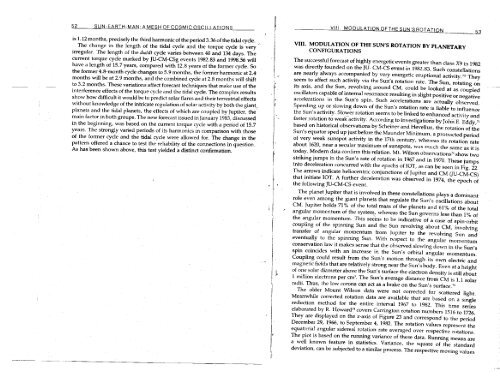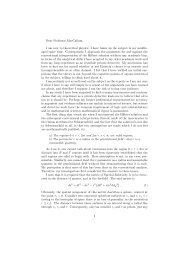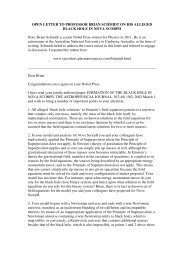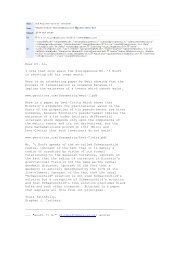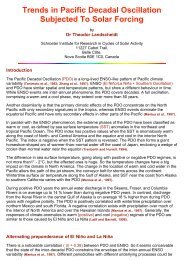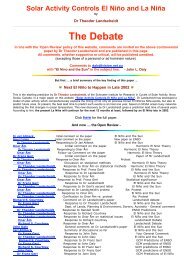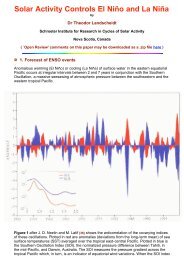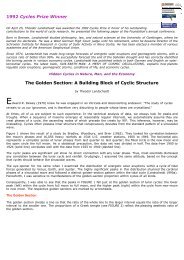Sun-Earth-Man - PlasmaResources
Sun-Earth-Man - PlasmaResources
Sun-Earth-Man - PlasmaResources
You also want an ePaper? Increase the reach of your titles
YUMPU automatically turns print PDFs into web optimized ePapers that Google loves.
52 SUN-EARTH-MAN: AMESH OFCOSMIC OSCILLATlONS<br />
is 1.12 months, precisely the third harmonic of the period 3.36 of the tidal cycle. ,<br />
The change in the length of the tidal cycle and the torque cycle is very<br />
irregular. The length of the dwidt cycle varies between 40 and 134 days. The<br />
current torque cycle marked by JU-CM-CSg events 1982.83 and 1998.56 will<br />
have a length of 15.7 years, compared with 12.8 years of the former cycle. So<br />
the former 4.8-month cycle changes to 5.9 months, the former harmonic at 2.4<br />
months will be at 2.9 months, and the combined cycle at 2.8 months will shift<br />
to 3.2 months. These variations affect forecast techniques that make use of the<br />
interference effects of the torque cycle and the tidal cycle. The cornplex results<br />
show how difficult it would be to predict solar flares and their terrestrial effects<br />
without knawledge of the intricate regulation of solar activity by both the giant,,<br />
planets and the tidal planets, the effects of which are coupled by Jupiter, the<br />
main factor in both groups. The new forecast issued in January 1983, discussed<br />
in the beginning, was based on the current torque cycle with a period of 15.7<br />
years. The strongly varied periods of its harmonics in comparison with those<br />
of the former cycle and the tidal cycle were allowed for. The change in the<br />
pattern offered a chance to test the reliability of the connections in question.<br />
As has been shown above, this test yielded a distinct confirmation.<br />
VIII. MODULATION OFTHESUN'S ROTATION 5 3<br />
VIII. MODULATION OF THE SUN'S ROTATION BY PLANETARY<br />
CONFIGURATIONS<br />
The successhl forecast of highly energetic events greater than class X9 in 1982<br />
was directly founded on the JU- CM-CS event in 1982.83. Such constellations<br />
are nearly always accompanied by very energetic emptional activit~.'~ They<br />
seem to affect such activity via the <strong>Sun</strong>'s rotation rate. The <strong>Sun</strong>, rotating on<br />
L,<br />
its axis, and the <strong>Sun</strong>, revolving around CM, could be looked at as coupled<br />
oscillators capable of internal resonance resulting in slight positive or negative<br />
accelerations in the <strong>Sun</strong>'s spin. Such accelerations are actually observed.<br />
Speed~ng up or slowmg down of the <strong>Sun</strong>'s rotation rate is liable to influence<br />
the <strong>Sun</strong>'s activity. Slower rotation seems to be linked to enhanced achv~ty and<br />
faster rotation to weak activity. According to investigations by John E. Ed&,''<br />
based on historical observations by Scheiner and ~evelius, the rotation of ;he<br />
<strong>Sun</strong>'s equator sped up just before the Maunder Minimum, a protracted period<br />
of very weak sunspot activity in the 17th century, whereas its rotation rate<br />
about 1620, near a secular maximum of sunspots, was much the same as it is<br />
today. Modern data conhrm this relation. Mt. Wilson ob~ervations'~ show two<br />
striking jumps in the <strong>Sun</strong>'s rate of rotation in 1967 and in 1970. These jumps<br />
into deceleration concurred with the epochs of IOT, as can be seen in Fig. 2.<br />
The arrows indicate heliocentric conjunctions of Jupiter and CM (JU-CM-CS)<br />
that initiate IOT. A further deceleration was observed in 1974, the epoch of<br />
the following JU-CM-CS event.<br />
The planet Jupiter that is involved in these constellations plays a dominant<br />
role even among the @ant planets that regulate the <strong>Sun</strong>'s oscillations about<br />
CM. Jupiter holds 71% of the total mass of the planets and 61% of the total<br />
angular momentum of the system, whereas the <strong>Sun</strong> governs less than 1% of<br />
the angular momentum. This se2ms to be indicative of a case of spin-orbit<br />
coupling of the spinning <strong>Sun</strong> and the <strong>Sun</strong> revolving about CM, involving<br />
transfer of angular momentum from Jupiter to the revolving <strong>Sun</strong> and<br />
eventually to the spinning <strong>Sun</strong>. With respect to the angular momentum<br />
conservation law it makes sense that the observed slowing down in the <strong>Sun</strong>'s<br />
spin coincides with an increase in the <strong>Sun</strong>'s orbital angular momentum.<br />
Coupling could result from the <strong>Sun</strong>'s motion through its own electric and<br />
magnetic fields that are relatively strong near the <strong>Sun</strong>'s body. Even at a height<br />
of one solar diameter above the <strong>Sun</strong>'s surface the electron density is still about<br />
1 million electrons per cm3. The <strong>Sun</strong>'s average distance from CM is 1.1 solar<br />
radii. Thus, the low corona can act as a brake on the <strong>Sun</strong>'s su~face.~<br />
The older Mount Wilson data were not corrected for scattered light.<br />
Meanwhile corrected rotation data are available that are based on a single<br />
reduction method for the entire interval 1967 to 1982. This time series<br />
elaborated by R. Howard7' covers Camngton rotation numbers 1516 to 1726.<br />
They are displayed on the x-axis of F~gure 23 and correspond to the period<br />
December 29, 1966, to September 4, 1982. The rotation values represent the<br />
equatorial angular s~dereal rotation rate averaged over respect~ve rotat~ons.<br />
The plot is based on the running variance of these data. Running means are<br />
a well known feature in statistics. Variance, the square of the standard<br />
deviation, can be sub~ected to a similar process. The respective moving values


